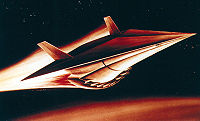Space plane
The intensified in the 1980s and again planned at the beginning of the new millennium -body aircraft are used as an alternative to the launch vehicles and space shuttles , currently for the transport of people and payloads into space , are developed are responsible. Space planes are expected to bring about an enormous reduction in transport costs and a considerable increase in the safety of space transport compared to today's systems.
Concepts and Projects
In contrast to the space shuttles, the idea of the space plane is to be able to take off on a normal runway like an airplane in order to reach an orbit . The most important difference to a launch vehicle or space shuttle is that a space aircraft has engines that take oxygen from the atmosphere ( ramjet and scramjet ), so that the amount of fuel carried to reach space can be reduced.
In addition to the development of the new types of propulsion that a spaceplane needs, one of the greatest problems is re-entry into the atmosphere after a successful orbital mission. Since the spaceplane must have an extremely good aerodynamic shape (arrow-shaped) for hypersonic flight in the atmosphere during the ascent, no ordinary heat shields such as those used in the space shuttle can be used. This increases the demands on the aircraft structure enormously and can hardly or not at all be solved with the materials available today.
Overall, there have been many spacecraft officially run spacecraft projects including:
All of these projects were sooner or later stopped for lack of money. Basic research on air-breathing rocket engines (see Boeing X-43A ) is currently underway, especially in the USA . In addition, the heat exchanger of the British Skylon project is being developed, a project that has not yet been specified in a planning stage.
Spurred on by the Ansari-X-Prize , private companies also grappled with the idea of a spaceplane, even if only with suborbital targets. SpaceShipOne successfully completed this competition on October 4, 2004. The successor SpaceShipTwo has completed its first test flights since 2010 and, according to plans, should start commercial transport of passengers into suborbital space from 2014. After delays in development and a crash in 2014, it was only on December 13, 2018 that the FAA reached space for the first time in a test flight.
See also
literature
- Matthew A. Bentley: Spaceplanes - from airport to spaceport , Springer, New York 2009, ISBN 978-0-387-76509-9
- Martin Caidin : Wings into space - the history and future of winged space flight , Holt, Rinehart and Winston, New York 1964
- Heribert Kuczera, et al .: Reusable space transportation systems , Springer, Berlin 2011, ISBN 978-3-540-89180-2 .
Web links
Individual evidence
- ^ Space shuttle for civilians , stern.de , January 24, 2008
